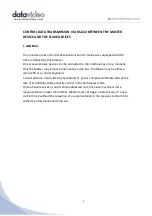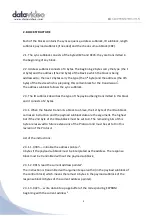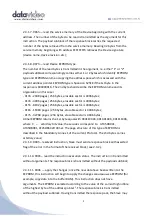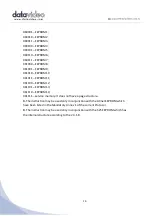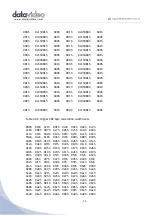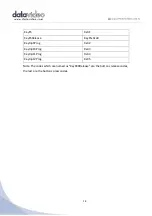
6
be inaccessible to the data exchange with the PC during the next 5 seconds or less;;
2.3.1.12. 00Bh – local time update. 3 bytes are transmitted as the arguments: clocks,
minutes and seconds in the binary code. The device status is sent back in the
response block (see 3.);
2.3.1.13. 00Ch – reserved instruction, Slave must send a response block with
asserted flag of the error in the format of the received block (see 2.3.2.).
2.3.1.14. 00Dh — device reset. The instruction in transmitted without arguments.
The response block is transmitted without the payload subblock. Having sent the
response block, the device reboots itself. It may be inaccessible for up to 16 seconds;
2.3.1.15. 00Eh – reserved instruction, Slave must send a response block with
asserted flag of the error in the format of the received block (see 2.3.2.).
2.3.1.16. 00Fh – reserved instruction, Slave must send a response block with asserted
flag of the error in the format of the received block (see 2.3.2.).
2.3.1.17. 010h — sector erase instruction4. A EEPROM sector accessed by the
current value of the address pointer is erased. The EEPROM is selected with the high
nibble of the address pointer highest byte. The instruction in transmitted without
arguments. The response block is transmitted without the payload subblock;
2.3.1.18. 011h — page write instruction
4
. The data to be written are sent as the
arguments. The response block is transmitted without the payload subblock;
2.3.1.19. 020h — the code of a pressed button instruction. The code of the pressed
or released button is transmitted in the only argument byte. It is possible to send the
instruction with the argument byte equal with 0. In this case, the Device shall
consider there is no any button pressed. The button codes are listed in the
recommended Annex 4 of the current Protocol. The device status is sent back in the
response block (see 3.);
2.3.1.20. 021h — T-bar position code instruction. The 1
st
and the 2
nd
arguments carry
the code of the position of the T-bar (lower byte ahead). The device status is sent
back in the response block (see 3.);


